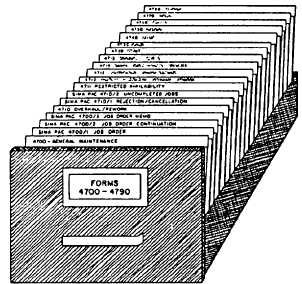| |
Figure 5-1.-Forms filed according to standard subject
identification codes (SSICs).
Related papers, analyses, surveys, or memoranda
pertaining to the form or related procedures;
information on contemplated revisions; or other
data
Records such as Forms Progress Record,
NAVSO 5213/12, SN 0104-LF-904-1020
This is helpful in providing usage data, progress
information, and so on. When a form is discontinued,
the reason could be noted on this record.
CROSS-REFERENCE.– Regardless of your
efforts to consolidate related information into one form
to serve a variety of purposes or functions, two or more
forms may still be required. Under this condition,
similar SSICs will probably be used (though not
required) for each form. Periodic review or the revision
or cancellation of any one of these related forms may
require similar action with the others. Across-reference
to such related forms tiled in their respective folders will
prove extremely helpful in effective forms
management.
DISCONTINUED FORMS.– When a form
becomes obsolete or is replaced by one prescribed by
higher authority, the folder is transferred to a separate
file. This file is organized in the same manner as the
active tile; that is, it is arranged by SSIC in numerical
order. The reason for the discontinuation of the form is
noted in the record before the folder is placed in the
discontinued file. Disposition of these tiles is governed
by the Navy and Marine Corps Records Disposition
Manual, SECNAVINST 5212.5C.
AREAS FOR POSSIBLE ANALYSIS
Forms dealing with a particular function or subject
matter; for example, personnel, administration, and cost
accounting, may provide reason for analysis with a view
toward combining or eliminating forms. These reasons
may include the following:
. Apparent duplication of records or forms for
performing the function. More than one office may
appear to be performing the same functions or
operations or, within one office, the types of forms used
or records maintained to perform the function may
appear to duplicate each other.
. More than one form appears to be used for the
same or similar function. (Here again you should study
operations with a view toward streamlining and
simplification.)
Usage of Forms
Estimates of annual usage entered on the forms by
the offices submitting them may indicate areas in which
to start analysis. One starting point often chosen is to
analyze the highest usage forms in the activity; for
example, the forms that are the 5 or 10 highest usage.
These may involve not only high printing costs but a
considerable man-hour expenditure on the procedures
for their preparation or use.
Information in Directives or Instructions
The following clues are available from the
directives submitted with the form.
FREQUENCY OF PREPARATION OR
USE.– Forms filled out or posted on a daily or weekly
basis may have a larger potential for clerical and
administrative savings or improvement than forms used
at less frequent intervals. If it is believed the frequency
of preparation or use can be reduced (from weekly to
monthly or other frequently), paper work can be cut.
DISTRIBUTION OF COPIES.– Each copy of a
form that is distributed can entail man-hours in its
processing and use whether it is the original or a copy.
Moreover, the provision of information or
might-have-a-need-for copies may result in a
considerable man-hour expenditure in distributing,
handling, and possibly filing whether any action is taken
or not. Examination of the actual use made of each copy
5-5
|

